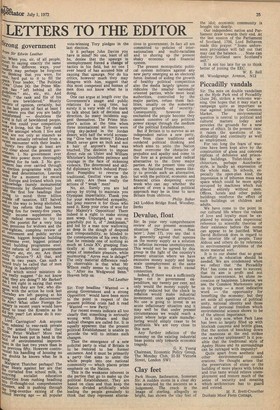Piccadilly vandals
Sir: The note on double vandalism at the Hyde Park end of Piccadilly (June 24), strikes a welcome warning. One hopes that it may start a campaign quite as important as that against joining the Common Market. The environmental question is central to political and cultural matters today and provides the grounds for a new sense of ethics. In the present case, it raises the questions of individuality and continuity as well as employment.
For too long the fears of wartime have been kept alive by the construction of glass and concrete replicas of defensive and prisonlike buildings. Toilet-block architecture, perhaps Auschwitzstyle, is hardly an expression of the whole man, In schools, especially the open-plan kind, the impression is of inhuman mass and space which could be more aptly occupied by machines which run almost entirely without men. Offices, hotels and other public buildings reinforce the effect of such buildings on children and adults.
We have come to the point in our cultural life where the values of love and loyalty must be explained by minute and impersonal reference to scientific theories of their existence before the terms can appear to be justified. What David Holbrook does in regard to the interior life of people, Tony Aldous and others do by reference to environmental problems of the more material sort.
It is to our shame that so great an effort in education should be needed. We are condemned when we reflect that 'the Piccadilly Plot' has come so near to success; that its aim is profit and not human convenience, let alone recreation or happiness. Likewise, we see, the Common Marketeers urge us to grasp — a most indicative word — the opportunity for benefiting the economy; but they set aside all questions of political unity, national identity and those issues of personal freedom which environmental science shows to be of the utmost importance. Is it only now, when Park Lane has been so largely filled up with blockish concrete and brittle glass, that the notion of knocking down the mansions at the end strikes one as rather unpleasant? Is it possible that the traditional style of Apsley House and its surroundings can be outraged with impunity? Quite apart from aesthetic and other environmental consid erations, the thought arises that the preservation of stone or the building of more places with bricks and true taste would relieve unemployment and restore much of the sense of security and meaning which architecture has to guard and extend.
M. R. Brett-Crowther Durham Moor Farm Cottage,






















































 Previous page
Previous page